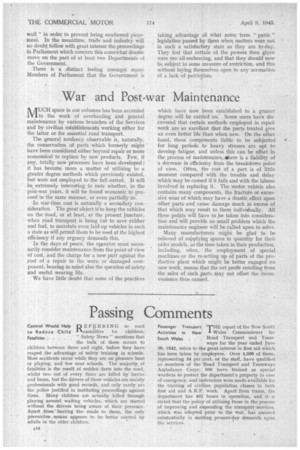War and Post-war Maintenance
Page 16

If you've noticed an error in this article please click here to report it so we can fix it.
MUCH space in our columns has been accorded to the work of overhauling and general maintenance by various branches of the Services and by civilian establishments working either for the latter or for essential road transport.
The general tendency observable is, naturally, the conservation of parts which formerly might have been considered either beyond repair or more economical to replace by new products. Few, if any, totally new processes have been developed ; it has become more a matter of utilizing to a greater degree methods which previously existed, but were not employed to the full extent. It will . be extremely interesting to note whether, in the post-war years, it will be found economic to proceed in the same manner, or even partially so.
In war-time cost is naturally a secondary consideration. The great object is' to keep the vehicles on the road, or at least, at the present juncture, when road transport is being Cut to save rubber and fuel, to maintain even laid-up vehicles in such a state as will permit them to be used at the highest efficiency if any urgency demands this.
In the days of peace, the operator must necessarily consider maintenance from the point of view of cost, and the charge for a new part against the .cost of a repair to the worn or damaged component, bearing in mind also the question of safety and useful wearing life.
We have little doubt that some of the practices which have now been established to a greater degree will be carried on.* Some users have discovered that certain methods employed in repair work are so excellent that the parts treated give an even better life than when new. On the other hand, those components liable to be subjected for long periods to heavy stresses are apt to develop fatigue, and unless this can be offset in the process of maintenance, lthere is a liability of a decrease in efficiency from the breakdown point. of view. Often, the cost of a part is of little moment compared with the trouble and delay which may be caused jilt fails and Nvith the labour involved in replacing it. The motor vehicle also contains many components, the fracture or excessive wear of which may have a drastic effect upon other parts and cause damage much in excess of that Which may result to them individually. All these points will have to ,be taken into consideration and will ,provide no small problem which the maintenance engineer will be called upon to solve.
Many manufacturers might be glad to be relieved of supplying spares in quantity for their older models, as the time taken in their production, including, often, the employment of special machines or the re-setting up of parts of the productive plant which might be better engaged on new work, means that the net profit resulting from the sales of such parts may not offset the inconvenience thus caused.




















































